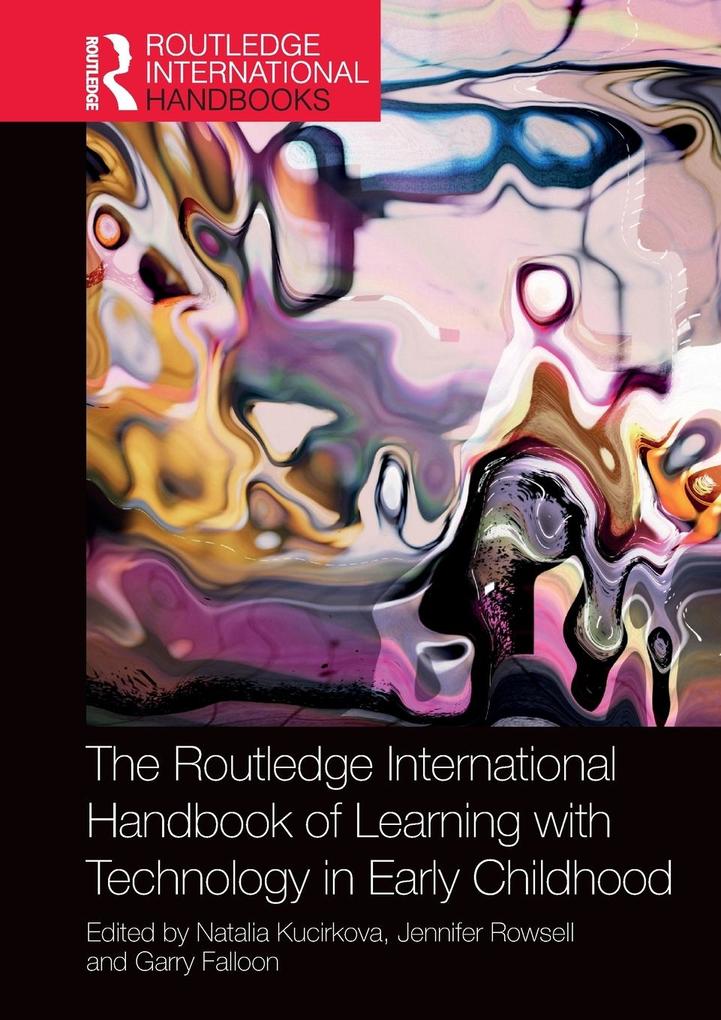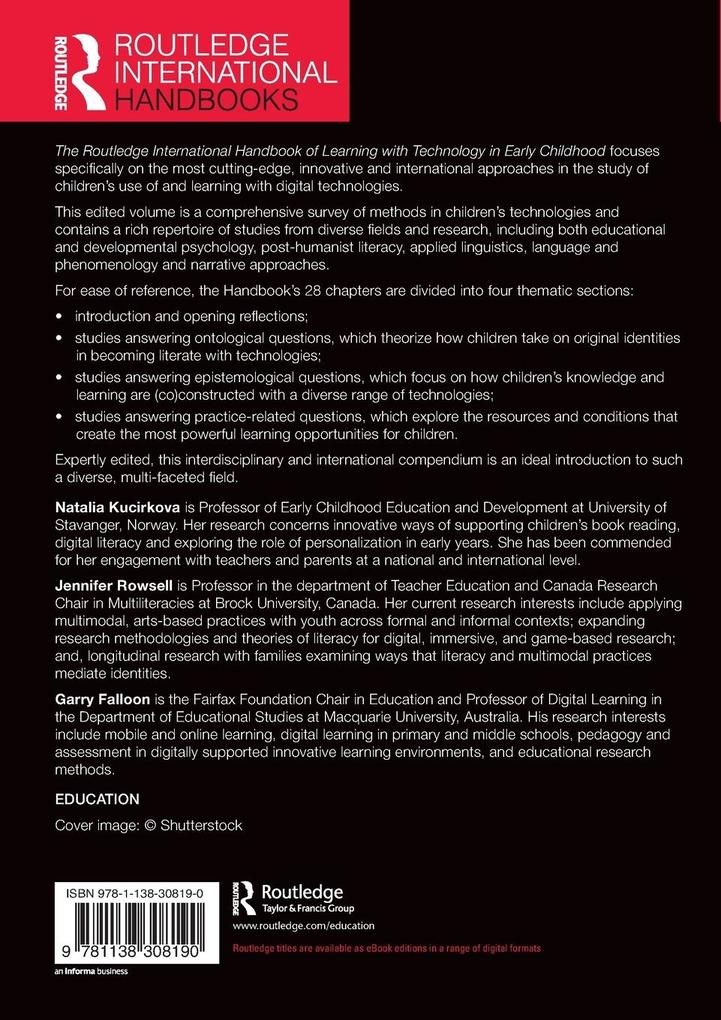
Zustellung: Di, 24.06. - Fr, 27.06.
Versand in 6 Tagen
VersandkostenfreiBestellen & in Filiale abholen:
This book brings together innovative work happening in childhood research across disciplinary boundaries and across the world. It focuses specifically on the most cutting-edge, innovative methodological approaches in the study of children's use and learning with digital technologies and children's experiences of key 21st century trends (e. g. immigration or multiculturalism). A true effort is made to have dialogues across diverse fields and contested fields of research (including educational psychology, post-humanist literacy, narrative approaches, developmental approaches). The book is a comprehensive survey of methods in the field of children's technologies. The volume is a substantive and strategic collection of international approaches to early childhood and technologies. The authors reflect on what works and what doesn't work in relation to specific innovative research methods.
Inhaltsverzeichnis
Foreword
Rosie Flewitt (University College of London, UK)
Section One: Studying children's contemporary play
Rosie Flewitt (University College of London, UK)
Section One: Studying children's contemporary play
- Cut it out! Materiality and Action in Children's Play and Toymaking Karen Wohlwend & Jaye Johnson Thiel Indiana University, USA
- Chestcam tales: Exploring embodied ethnography with young children Jackie Marsh, University of Sheffield, UK
- The development of childhood cultures Anne Haas Dyson, Illinois University, USA
- Meeting the needs of students in a multilingual classroom: Linking Research to Practice Rahat Zaidi, University of Calgary, Canada
- Research with children with SEN Melissa Allen, Lancaster University, UK
- Children from diverse backgrounds Jim Anderson, British Columbia
- Learning at home Laidlaw, O'Mara & Wong, Deakin University, Australia
- Community-based research Pam Whitty, University of New Brunswick, Canada
- Using magnetic resonance imaging in infants and young children and its implication for bridging the fields of Neuroscience and Education Nadine Gaab, Harvard University, USA
- "Talk into my GoPro, I'm making a movie!" Using digital ethnographic methods to explore children's experiences in the woods Debra Harwood & Diane Collier, Brock University, Canada
- Deep hanging out: artifactual literacies and ethnographic methods Margaret Somerville & Sarah Powell, Western Sydney University, Australia
- Getting away from the screen: the play affordances of Internet connected toys Donell Holloway, Edith Cowan University, Australia
- This is the stuff that literacies are made of: Researching children's learning with grandparents and other elders through ethnographic methods Rachel Heydon, & Xiaoxiao Du, University of Western Ontario, Canada
- Children and parents interacting together with an app support Kathy Sylva & Fiona Roberts, University of Oxford, UK
- Children learning in their families Tisha Lewis, University of Georgia, USA
- Embodiment Kerryn Dixon, Wits University, South Africa
- Technologies, affordances, children and (embodied) reading: a call for intedisciplinarity Anne Mangen, Trude Hoel, Thomas Moser, University of Oslo, Norway
- Valuing Signs of Learning: A Multimodal Perspective on Observation and Digital Documentation in Early Years Classrooms Kate Cowan, University College London, UK
- Eye-tracking and e-books Zsofia Takacs, Eö tvö s Lorá nd University, Hungray
- Lab-based studies of children's reading on screen Brenna Hassinger and Rebecca Dore, University of Delaware, USA
- Visual methods for studying children's interactions on screen Abi Hackett & Lucy Caton, Manchester Metorpolitan University, UK
- Who's helping who? : Young children seeking help when learning to write Annette Woods, Queensland University of Technology, Australia
- Children's literature and critical literacy Peggy Albers, Georgia State University, USA, together with Vivian Vasquez and Jerry Harste
- Methodologies without methodology: (Re)imagining research practices when thinking with poststructural and posthumanist theories Candace Kuby, Missouri University, USA
- Studying science apps in low-income pre-schools Lena Lee, Miami University, USA
- Storying as a methodology in early years classrooms Cathy Burnett and Guy Merchant, Sheffield Hallam University, UK
- Student generated visual narratives: lived experiences of learning Narelle Lemon, La Trobe University, Australia
- Arts-based methods
Section Two: Studying specific groups of children
Section Three: Studying children's practices at home and in lab settings
Section Four: Children's global practices and movement through space
Section Five: Studying children's learning with others
Section Six: Children's learning through body, embodiment and haptics
Section Seven: Studying reading and interacting on screen
Section Eight: Children's multiliteracies
Section Nine: Children's drawing, mark-making and arts
Produktdetails
Erscheinungsdatum
16. Januar 2020
Sprache
englisch
Seitenanzahl
442
Herausgegeben von
Natalia Kucirkova, Jennifer Rowsell, Garry Falloon
Verlag/Hersteller
Produktart
kartoniert
Gewicht
782 g
Größe (L/B/H)
246/174/24 mm
ISBN
9781138308190
Entdecken Sie mehr
Bewertungen
0 Bewertungen
Es wurden noch keine Bewertungen abgegeben. Schreiben Sie die erste Bewertung zu "The Routledge International Handbook of Learning with Technology in Early Childhood" und helfen Sie damit anderen bei der Kaufentscheidung.









